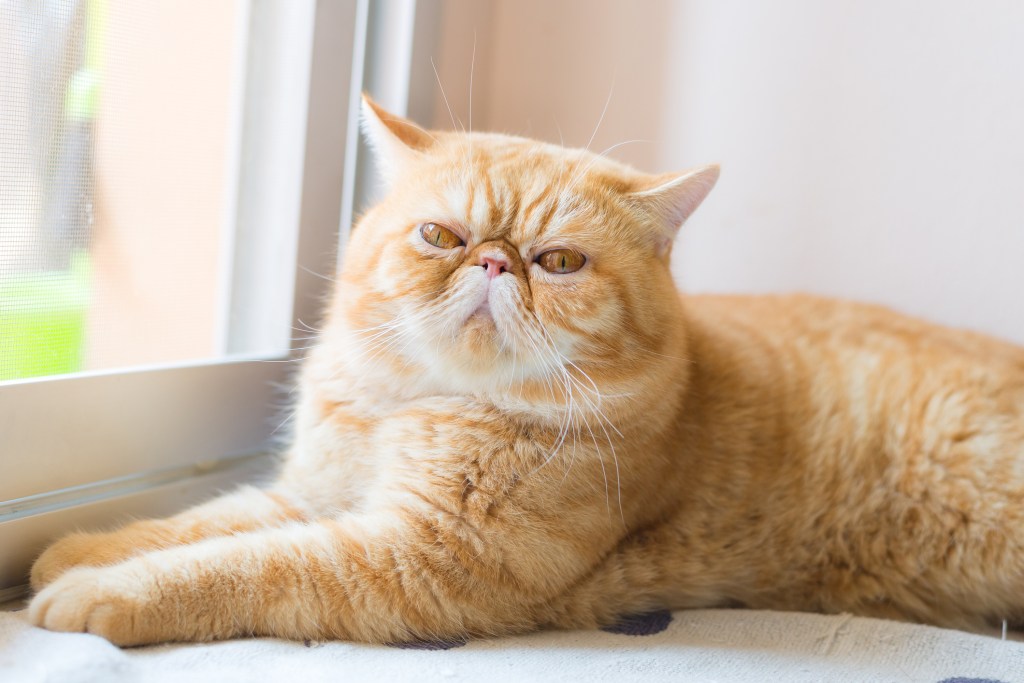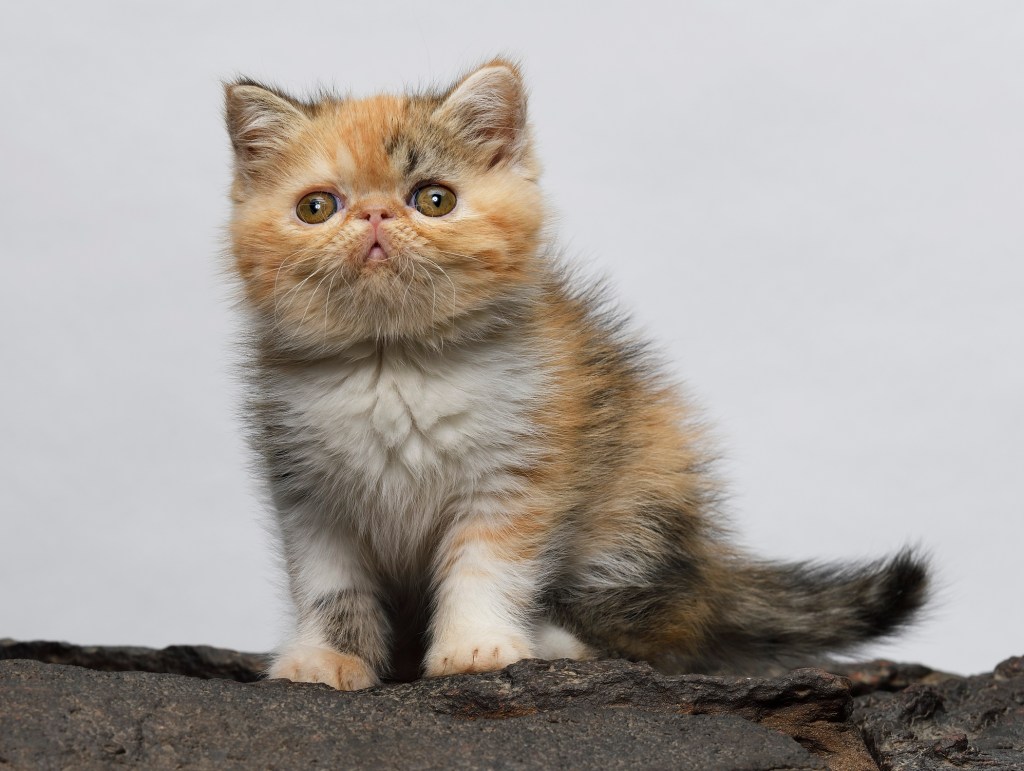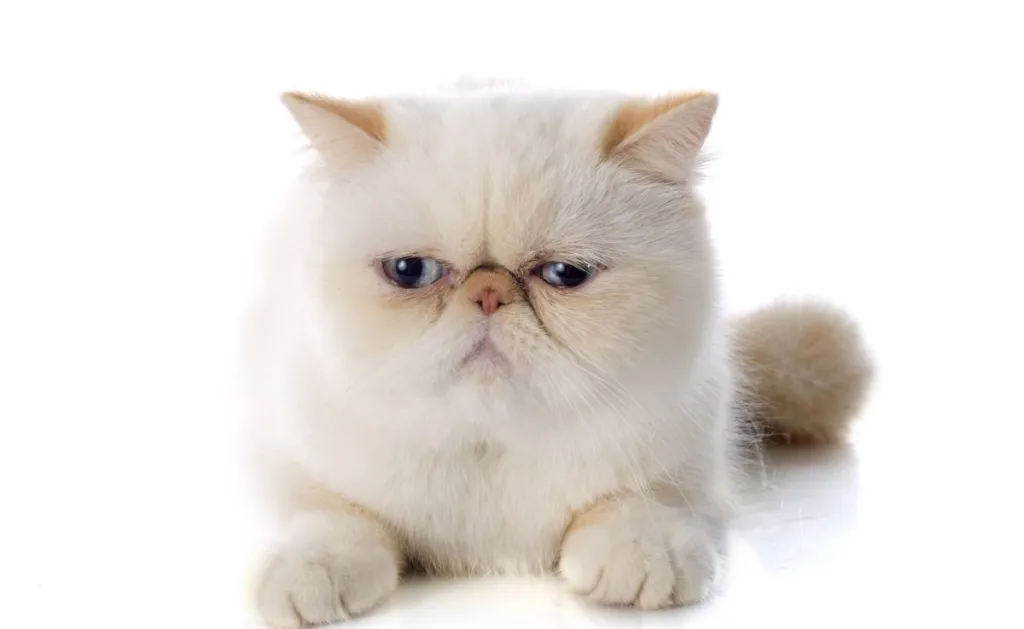The Exotic Shorthair is known for their plush, teddy bear-like appearance and easygoing temperament. Developed as a short-haired counterpart to the Persian, the Exotic Shorthair has a compact and well-muscled body with a broad face, round eyes, and a sweet expression. The breed is characterized by their dense and soft coat, which comes in various colors and patterns. Despite their Persian ancestry, Exotic Shorthairs require less grooming due to their shorter fur, making them a popular choice for cat enthusiasts who appreciate the Persian look without the extensive grooming commitment.
Known for their affectionate and laid-back nature, Exotic Shorthairs are often described as lap cats who enjoy lounging and cuddling with their owners. They are adaptable to various living environments and get along well with children and other pets. Their friendly disposition and calm demeanor make them well-suited for indoor living, and they thrive on human interaction. With their endearing appearance and amiable personality, Exotic Shorthairs make wonderful companions for individuals and families alike, offering the perfect blend of charm and low-maintenance care.
When considering an Exotic cat, it’s advisable to prioritize adopting from rescue organizations or shelters to provide a loving home to a cat in need. However, if you decide to purchase, it’s crucial to choose a reputable breeder. Conduct thorough research to ensure that the breeder follows ethical practices and prioritizes the well-being of their cats. Reputable Exotic cat breeders prioritize the health and temperament of their cats, conduct necessary health screenings, and provide a nurturing environment for the kitties. This active approach ensures that you bring home a healthy and happy kitty while discouraging unethical breeding practices.
Quick Facts
- Origin: United States, 1960s, bred by crossing Persians with American Shorthairs to achieve a short-haired version with the Persian’s luxurious features.
- Size: Medium (8-15 pounds), with females generally smaller than males.
- Breed Group: Shorthair
- Lifespan: 12-15 years
- Coat: Short, thick, and plush, with various colors and patterns like solid, tabby, bi-color, and tortoiseshell.
- Temperament: Gentle, affectionate, calm, playful when young, enjoys lounging and attention.
- Exercise Needs: Low to moderate – appreciates playtime but content with quiet cuddles.
- Training: Adaptable to training with positive reinforcement, less demanding than their Persian cousins.
- Grooming: Weekly brushing recommended to prevent matting, especially around the ears and undercoat.
- Health: Generally healthy, but prone to some Persian-related conditions like brachycephalic syndrome (due to flat face) and eye problems.
- Some people believe that Garfield, the cartoon cat, is an Exotic.
- Occasionally, Exotics will have litters with long hair. Some registries refer to them as Persians, others as Exotic Longhairs.
- Exotics are nicknamed the “Lazy Man’s Persian,” since they have the same pinched, doll-like face without the heavy grooming.
Exotic Pictures



-
Affectionate with Family
Some cat breeds are typically independent and aloof, even if they’ve been raised by the same person since kittenhood; others bond closely to one person and are indifferent to everyone else; and some shower the whole family with affection. Breed isn’t the only factor that goes into affection levels; cats who were raised inside a home with people around feel more comfortable with humans and bond more easily.

See Cats Less Affectionate with Family -
Amount of Shedding
If you’re going to share your home with a cat, you’ll need to deal with some level of cat hair on your clothes and in your house. However, shedding does vary among the breeds. If you’re a neatnik, you’ll need to either pick a low-shedding breed or relax your standards. This furniture cover can make it easier to clean up cat hair and keep it off your sofa!
-
General Health
Due to poor breeding practices, some breeds are prone to certain genetic health problems. This doesn’t mean that every cat of that breed will develop those diseases; it just means that they’re at an increased risk. If you’re looking only for purebred cats or kittens, it’s a good idea to find out which genetic illnesses are common to the breed you’re interested in.
-
Potential for Playfulness
Some cats are perpetual kittens—full of energy and mischief—while others are more serious and sedate. Although a playful kitten sounds endearing, consider how many games of chase the mouse-toy you want to play each day, and whether you have kids or other animals who can stand in as playmates. A classic wand cat toy like this one is perfect for playful felines!
-
Tendency to Vocalize
Some breeds sound off more often than others with meows, yowls, and chattering. When choosing a breed, think about how the cat vocalizes and how often. If constant “conversation” drives you crazy, consider a kitty less likely to chat.
-
Kid-Friendly
Being tolerant of children, sturdy enough to handle the heavy-handed pets and hugs they can dish out, and having a nonchalant attitude toward running, screaming youngsters are all traits that make a kid-friendly cat. Our ratings are generalizations, and they’re not a guarantee of how any breed or individual cat will behave; cats from any breed can be good with children based on their past experiences and personality.
-
Friendly Toward Strangers
Stranger-friendly cats will greet guests with a curious glance or a playful approach; others are shy or indifferent, perhaps even hiding under furniture or skedaddling to another room. However, no matter what the breed, a cat who was exposed to lots of different types, ages, sizes, and shapes of people as a kitten will respond better to strangers as an adult.
-
Easy to Groom
Some breeds require very little in the way of grooming; others require regular brushing to stay clean and healthy. Consider whether you have the time and patience for a cat who needs daily brushing. You should definitely pick up this awesome de-shedding tool for cats of any hair length!
-
Intelligence
Some cat breeds are reputed to be smarter than others. But all cats, if deprived the mental stimulation they need, will make their own busy work. Interactive cat toys are a good way to give a cat a brain workout and keep them out of mischief. This scratcher cat toy can keep your smart kitty busy even when you’re not home!
-
Pet Friendly
Friendliness toward other household animals and friendliness toward humans are two completely different things. Some cats are more likely than others to be accepting of other pets in the home.
Exotic History
If the Persian is a cat in a glamorous evening gown, the Exotic is the Persian stripped down to its skivvies. The Exotic Shorthair, or Exotic for short, is a Persian of a different coat. The new breed first began to be developed in the 1950s by crossing Persians with American Shorthairs and, later, other shorthaired breeds such as the Burmese and the Russian Blue, then breeding back to Persians once the short coat was achieved. The eventual result was a cat with the same features and personality as the Persian but wrapped in a short, plush, easy-care coat.
The cross, which had originally been intended to bring the Persian’s striking silver color and green eyes to the American Shorthair, was controversial at first, but Persian breeders became intrigued by the new look and began to cooperate in the development of what became known as the Exotic.
The Cat Fanciers Association recognized the breed in 1967 and called it the Exotic. In some other associations, it’s known as the Exotic Shorthair to differentiate it from the Exotic Longhairs that sometimes appear in Exotic litters and are considered by some associations as a breed unto themselves. The International Cat Association recognized the breed as the Exotic Shorthair in 1979. Today Exotics are recognized by all cat registries. Exotics these days are outcrossed only to Persians and Himalayans, not to any shorthaired breeds.
Exotic Size
This is a medium-size cat. Exotics usually have a weight range of 7 to 12 pounds.
Exotic Personality
Like the Persian, the Exotic is sweet, docile and quiet, but don’t get the idea that she is merely an adornment for the home. She loves to play when she’s not sitting in a lap or being petted. Exotics have a reputation for being more active and curious than their Persian siblings, and they are more suited to an active family. Males are said by some to be sweeter and more affectionate than females, who are sometimes described as aloof.
Exotics enjoy batting at toys for as long as you will play with them but are capable of entertaining themselves when their people are busy or away. They follow faithfully after family members and wait patiently for any attention to come their way. Exotics are little heard, but when they do speak it is in a soft, pleasant and musical voice. An Exotic’s needs are simple: regular meals, a little playtime with a catnip mouse or feather teaser, and lots of love, which is returned many times over.
Exotic Health
Both pedigreed cats and mixed-breed cats have varying incidences of health problems that may be genetic in nature. Although they are beautiful and sweet, Exotics are prone to a number of potential health problems, most commonly related to their facial structure:
- Breathing Difficulty: Brachycephalic syndrome is a condition that affects certain cat breeds with distinctive short-nosed or “brachycephalic” facial features. Breeds prone to this syndrome include Persian cats, Himalayans, and Exotic Shorthairs, among others. Brachycephalic cats have a distinctive appearance characterized by a short skull, flat face, and compressed upper respiratory tract.
- Dental Malocclusions: Dental malocclusions in cats refer to misalignments of the teeth or jaws, disrupting the normal occlusion, or the way the upper and lower teeth fit together when the mouth is closed. Malocclusions can occur in various degrees of severity and may affect a cat’s ability to eat, groom, or may cause discomfort.
- Excessive Tearing: Excessive tearing in cats, also known as epiphora, can be caused by various factors. While some tearing is normal, persistent or increased tearing may be indicative of an underlying issue.
- Eye Conditions: Entropion in cats is a medical condition where the eyelids, usually the lower eyelids, roll inward, causing the fur and skin to rub against the cornea (the clear front part of the eye). This can lead to irritation, discomfort, and potential damage to the cornea. Entropion is not as common in cats as it is in some dog breeds, but it can still occur.
- Heat Sensitivity: Cats can be sensitive to heat, and excessive heat can pose risks to their health.
- Polycystic Kidney Disease: Polycystic Kidney Disease (PKD) is an inherited genetic disorder that affects cats. It is characterized by the formation of fluid-filled cysts within the kidneys, which can gradually lead to kidney enlargement and impaired kidney function. PKD is most commonly observed in Persian cats, but it can also affect other breeds.
- Ringworm: Ringworm in cats is a fungal infection caused by dermatophytes, which are fungi that can infect the skin, hair, and nails. Despite its name, ringworm is not caused by a worm but rather by various fungi, with the most common culprit being Microsporum canis. Ringworm is contagious and can affect not only cats but also other animals and humans.
- Seborrhea Oleosa: Seborrhea oleosa, also known as oily seborrhea, is a skin condition in cats characterized by excessive oil production. This condition is often associated with an overactive sebaceous (oil-producing) gland, leading to greasy and oily skin and coat. Seborrhea oleosa is a form of feline seborrheic dermatitis, a group of skin disorders that affect the sebaceous glands.
Exotic Care
The Exotic is often nicknamed “the lazy man’s Persian.” Comb the Exotic twice a week to remove dead hair and keep the coat shiny and healthy. A monthly bath is a good idea. Be sure to blowdry the cat thoroughly.
Excessive tearing can be a problem in this breed, so wipe the corners of the eyes clean daily to prevent under-eye stains from forming. Brush the teeth to prevent periodontal disease. Daily dental hygiene is best, but weekly brushing is better than nothing.
It’s a good idea to keep an Exotic as an indoor-only cat. He’s not a scrapper and would fare poorly against other cats, dogs, coyotes and the other dangers that face cats who go outdoors. Exotics who go outdoors also run the risk of being stolen by someone who would like to have such a beautiful cat without paying for it.
Exotic Coat Color And Grooming
In all respects but coat length, the Exotic shares the Persian’s sweet expression and soft round lines. It has a large, round head; large, round eyes; a short nose; full cheeks; and small ears with rounded tips. The head is supported by a short, thick neck and a deceptively sturdy, muscular body—a type known as “cobby.”
An Exotic’s legs are short, thick and strong with large, round, firm paws. The tail is short but proportional to the length of the cat’s body. A medium-length soft, thick, plush coat with a rich, thick undercoat completes the Exotic’s look. It does not have the ruff or the plumelike tail of the Persian.
Exotics come in different “looks,” known as extreme and traditional. “Extreme” Exotics, those seen in the show ring, have a flatter face, which may come with breathing problems. Cats with the traditional look have a more old-fashioned appearance, with a face that is not as flat and a nose that is set lower on the face with more of a “break,” permitting easier breathing. They are registered by the Traditional Cat Association.
Exotics of all stripes stand out for their infinite variety of coat colors and patterns. Imagine, if you will, seven solid color divisions — white, blue, black, red, cream, chocolate and lilac — plus silver and golden division colors of chinchilla and shaded silver or golden and blue chinchilla and blue shaded silver or golden; and then there are the shaded, smoke, tabby, calico, particolor and bicolor divisions. That’s not counting the various pointed patterns of the Himalayan.
Eye color is related to coat color. For instance, white Exotics have deep blue or brilliant copper eyes, or odd eyes—one copper and one blue; other solid-colored Exotics have brilliant copper eyes; silver and golden Persians have green or blue-green eyes; and so on.
Children And Other Pets
Exotics are adaptable and can do well in homes with children who treat them nicely. They also get along with cat-friendly dogs.
Exotic Rescue Groups
More Info For You
If you’re also looking for a dog, check out DogTime’s dog breed page!





